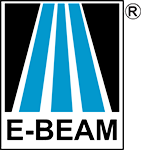Polymer Modification
Let’s enhance your polymer materials to help make your great products EVEN better!
How does E-beam crosslinking work?
Electron beam processing effectively and efficiently creates beneficial changes in material properties and performance with processes such as polymer crosslinking, long-chain branching and chain scissioning.
The process involves accelerating a beam of electrons to near light speed. It then passes through a scan chamber, and transitions into a curtain of electrons. Materials moving through the chamber on a high-speed conveyor system are showered with these high-energy electrons.
These electrons penetrate the material with a precise, predetermined dose and – depending on the material being processed and the dose that is being applied – several different effects occur.
E-beam crosslinking does not require any additives nor does it generate hazardous chemical by-products. This crosslinking method is energy efficient, and the minimal amount of required exposure time to the e-beam helps ensure high throughputs.
As an example, consider polyethylene and its many uses. The commonplace plastic is used in building materials, household products, and used for a massive variety of plastic goods. Its low melting point has become essential to injecting molding, yet retains properties like high ductility and chemical resistance.
Polyethylene has been altered over the years to serve more specific functions. High-density polyethylene is often used for underground storm drain systems, a majority of children’s toys, and even milk jugs. Inversely, low-density polyethylene is used in a multitude of plastic goods for its flexibility.
Even though this material has seen use since the 1930s, we are still discovering ways it can be improved, namely through crosslinking polymers. E-Beam processing can dramatically change the properties of this material for the better.
E-Beam Crosslinking Steps

Product is received & checked in

Product is staged in the processing area

Product passes through a curtain of electrons and is processed

Product is repackaged if necessary and awaits dosimetry

Product is promptly returned to you
E-Beam Polymer Modification Applications
Plastic Parts Crosslinking
E-beam crosslinking provides all of chemical crosslinking’s advantages of having a thermoplastic turn into a thermoset–without the use of harmful chemicals.
Electron beam technology allows for effective and efficient processing, creating useful changes in material properties, such as increased durability, increased chemical resistance, and increased material strength through crosslinking.
The use of e-beam technology often doesn’t require additives, nor does it generate hazardous chemical by-products. The plastic parts crosslinking method is energy efficient, and the minimal amount of exposure time needed helps ensure high throughputs.
Electron beam crosslinking is most frequently used for polyethylene and ethylene-based copolymers, but there is a growing amount of e-beam crosslinking of engineering polymers like polyamides and fluoropolymers, including PVDF and ETFE, in specialty wire and cable and molded parts.
- Gaskets and seals
- Automotive parts (Check out our Crash Course Video on Crosslinking Under the Hood)
- Connectors
- Mouth guards
- Medical casts
- Plumbing components
- Ice maker tubing
- Risers
- Manifolds
Wire, Cable & Tubing
E-beam irradiation provides quality crosslinking and polymer modification for wire, cable, and tubing products. E-beam crosslinking often does not require any additives, nor does it generate hazardous chemical by-products. E-beam crosslinking does not require the hours of cure time needed for other chemical crosslinking methods. E-beam is energy efficient, and the minimal amount of exposure time helps ensure high throughputs.
We have more than 500kW of installed accelerator capacity with a network of facilities, and flexible handling equipment such as high-speed reel-to-reel equipment to handle all applications.
Heavy Wall Cable
Higher tensile strength and improved thermal resistance gives you an improved product above your competitor’s. E-BEAM has the capability to crosslink any length, diameter, and gauge cable.
PEX Pipe Tubing
Polyethylene crosslinked (PEX) tubing boosts thermal resistance up to 180 F over the standard 140 F of uncrosslinked polyethylene. With both freezing and extreme heat resistance, plumbing with PEX pipe has become extremely common.
Heat Shrink Tubing
With the ability to improve resistances against abrasions, cracking, and fatigue, crosslinked tubing protects wiring like no other heat shrink product on the market.
Crosslinked, Foam, Film & Sheet
E-beam irradiation provides quality crosslinking for continuous sheet applications.
The e-beam crosslinking process often does not require any additives, nor does it generate hazardous chemical by-products. This crosslinking method is energy efficient, and the minimal amount of exposure time to the e-beam helps ensure high throughputs.
(For more info on e-beam crosslinking vs. chemical crosslinking, see this article on the topic.)
We use high-speed reel-to-reel equipment with the capability to handle all applications, ranging from films as thin as 5 mils (0.005”) to sheet as thick as 0.25 inches.
- automotive interiors
- heat shrink plastics
- adhesive release liners
- plastic sheet goods
- foam
Polymer Long Chain Branching
Polymer long chain branching is used to modify the processability and melt properties of polymer pellets. The e-beam irradiation creates side chains and often increases molecular weight. This is done without creating a 3D network, such as is created during the crosslinking process.
Crosslinking is generally performed on molded parts, whereas long chain branching is performed on pellets. A much lower dose is needed for long chain branching than for crosslinking.
To learn more about the history and technology behind long chain branching, check out our 3-part blog series.
The side chains often entangle, increasing the melt strength of the polymer, allowing for downgauging, long draw thermoforming, creation of lower density foams, and other applications.
- Foam
- Film
- Extrusion coating
- Extrusion blow molding
- Thermoformed trays and containers
- Automotive interiors
Chain Scission
Electron beam processing can modify properties by creating controlled degradation – or chain scission – in certain materials. For example, PTFE can be processed to create a micropowder that can be brought to a specific particle size. Specific particle sizes are increasingly useful in products such as inks, coatings and lubricants.
Polymer crosslinking and chain scissioning are related but actually opposite processes. Learn more about the differences between crosslinking and scissioning in our blog article on this topic.
Ingredients can be chains scissioned to make them more soluble for solution applications.
Chain scission via electron beam also modifies polypropylene, resulting in a more homogenized melt flow.
You can learn more about the 3 types of polymer modification (crosslinking, branching, and chain scissioning) in this E-BEAM Crash Couse video.
- Injection molding (reduced warping)
- Films (improved opticals)
- Fiber/textiles
- Pharmaceuticals
- Packaging
- Cellulosic materials
- Natural rubbers
Who is E-Beam crosslinking for?
You need to make your products perform better and cost less. You need customized, flexible, and sometimes top-secret solutions delivered by trusted partners.
We understand that need. E-BEAM Services uniquely combines its technical expertise with a deep understanding of each client’s individual needs to provide solutions that meet and exceed their performance and profitability objectives.
With more than 500kW of installed accelerator capacity, the ability to process more than one billion pounds of material annually, a network of facilities, and flexible handling equipment we’re ready to not just meet but to exceed all of your polymer modification needs!
Why E-Beam Crosslinking Matters to You
- No harmful chemicals
- Increased tensile and impact strength
- Increased durability
- Improved environmental stress crack resistance
- Increased material strength
- Resistance to chemical solvents
- Environmentally friendly
- Increased creep resistance
- Improved abrasion resistance
- Improved barrier properties
- Increased material stability
- Shrink memory
Are you ready to convert to E-beam technology?
Contact us to speak with one of our Technical Services reps, or visit our extensive reference library to learn more E-beam crosslinking.





